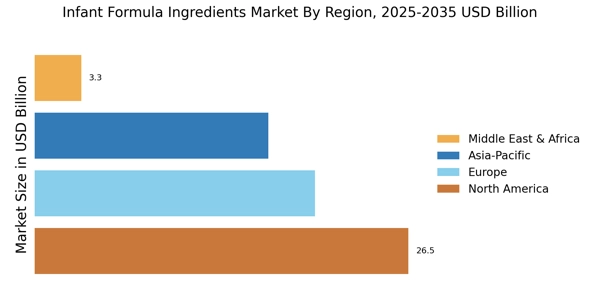Growing Awareness of Infant Nutrition
The increasing awareness regarding the importance of infant nutrition is a pivotal driver in the Infant Formula Ingredients Market. Parents and caregivers are becoming more informed about the nutritional needs of infants, leading to a surge in demand for high-quality ingredients. This trend is reflected in the market data, which indicates that the infant formula segment is projected to grow at a compound annual growth rate of approximately 6% over the next few years. As a result, manufacturers are focusing on sourcing premium ingredients that meet the evolving expectations of health-conscious consumers. This heightened awareness not only influences purchasing decisions but also encourages innovation in ingredient formulation, thereby shaping the future landscape of the Infant Formula Ingredients Market.
Rising Birth Rates in Emerging Economies
Rising birth rates in emerging economies are contributing to the expansion of the Infant Formula Ingredients Market. As populations grow, the demand for infant nutrition products increases, particularly in regions where traditional breastfeeding practices may be declining. This demographic shift presents a lucrative opportunity for manufacturers to introduce a variety of infant formula products tailored to local preferences and nutritional needs. Market data reveals that regions experiencing significant population growth are also witnessing a parallel increase in the consumption of infant formula, thereby driving demand for diverse ingredients. Consequently, this trend is likely to influence the strategic direction of companies operating within the Infant Formula Ingredients Market.
Consumer Preference for Clean Label Products
Consumer preference for clean label products is reshaping the Infant Formula Ingredients Market. Parents are increasingly seeking transparency in ingredient sourcing and formulation, favoring products that contain recognizable and natural ingredients. This shift towards clean labeling is prompting manufacturers to reformulate their products, eliminating artificial additives and preservatives. Market data indicates that the clean label trend is gaining momentum, with a significant percentage of consumers willing to pay a premium for products that align with their values. As a result, this consumer behavior is driving innovation and encouraging brands to highlight the quality and purity of their ingredients, ultimately influencing the competitive landscape of the Infant Formula Ingredients Market.
Regulatory Support for Infant Nutrition Standards
Regulatory support for infant nutrition standards plays a crucial role in shaping the Infant Formula Ingredients Market. Governments and health organizations are increasingly establishing guidelines that promote the use of safe and nutritious ingredients in infant formulas. This regulatory framework not only ensures consumer safety but also fosters trust in the products available in the market. As a result, manufacturers are compelled to comply with these standards, leading to an overall enhancement in product quality. Market data indicates that regions with stringent regulations tend to exhibit higher growth rates in the infant formula sector, as consumers are more likely to choose products that adhere to recognized safety and nutritional standards within the Infant Formula Ingredients Market.
Technological Advancements in Ingredient Processing
Technological advancements in ingredient processing are significantly impacting the Infant Formula Ingredients Market. Innovations in processing techniques, such as spray drying and microencapsulation, enhance the nutritional profile and shelf life of ingredients. These advancements allow manufacturers to create formulas that retain essential nutrients while improving taste and digestibility. Market data suggests that the adoption of these technologies is expected to increase, with a notable rise in the use of functional ingredients that cater to specific dietary needs. Consequently, this trend not only boosts product quality but also drives competition among manufacturers, compelling them to invest in research and development within the Infant Formula Ingredients Market.


















Leave a Comment